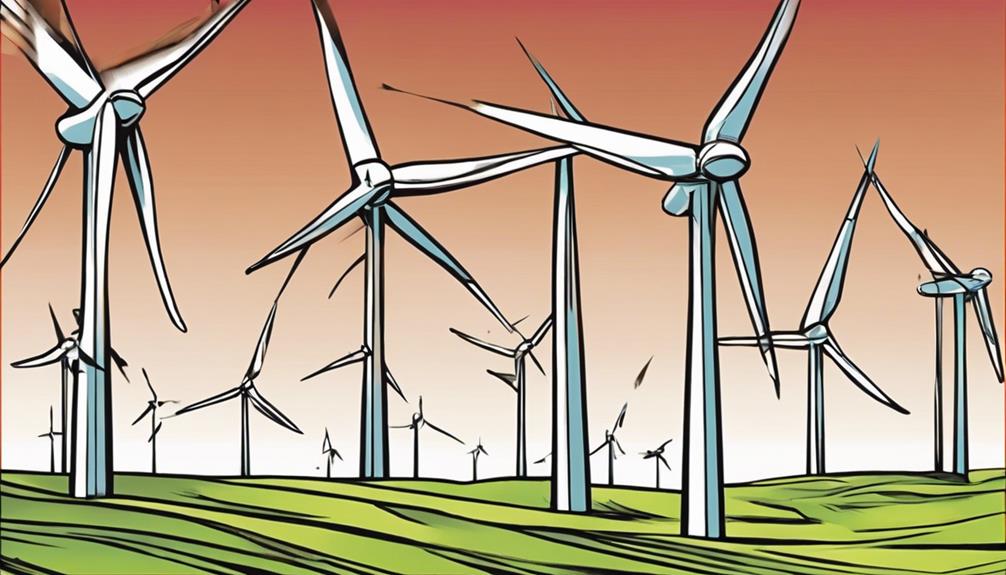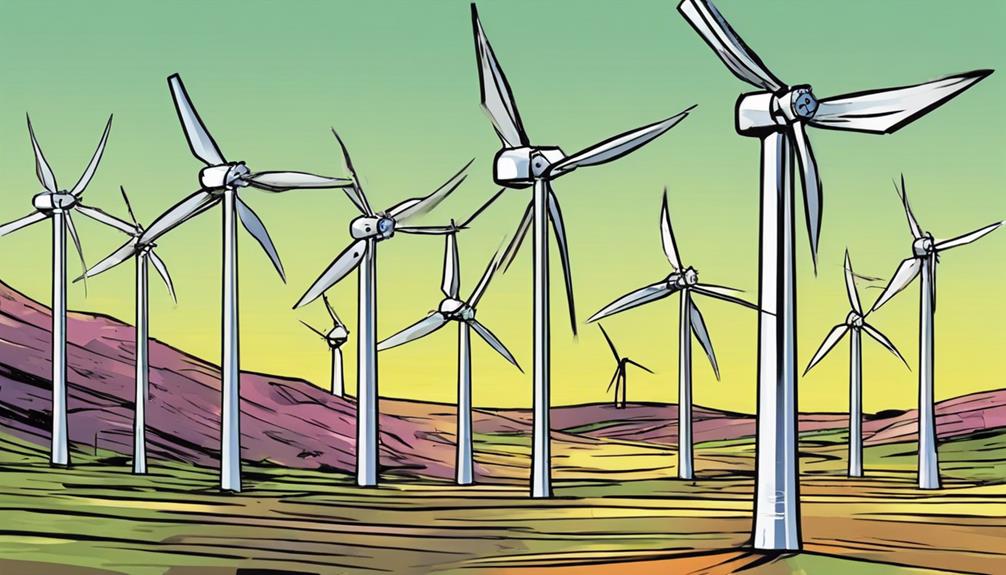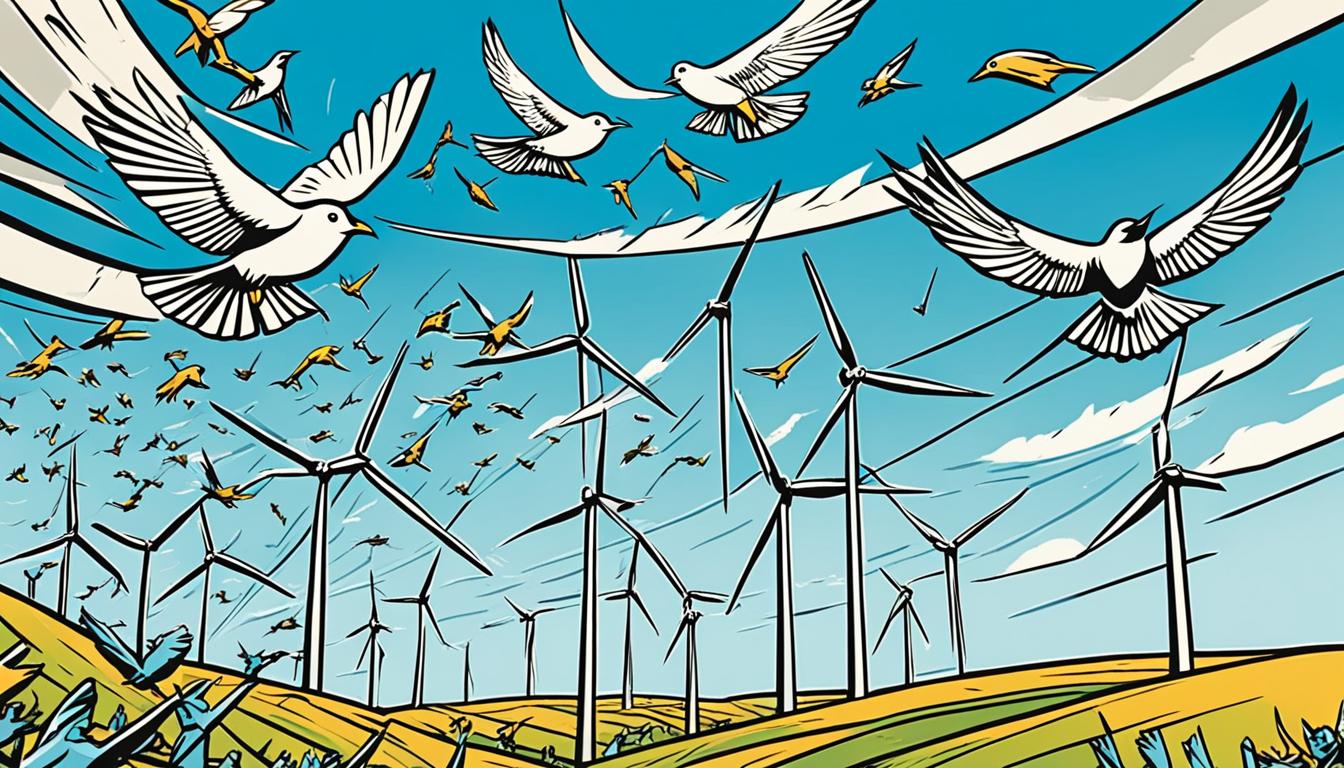For the most effective wind turbine design, consider opting for three blades. They offer peak efficiency and improved stability, striking a balance for best energy production. Three-bladed turbines have advantages like lower noise levels and enhanced performance, making them a reliable source of renewable energy. If you are looking to maximize efficiency and durability, choosing a three-blade design is your top choice.
Key Takeaways
- Three blades offer peak efficiency and stability in wind turbine design.
- Modern turbines with three blades achieve up to 80% efficiency.
- Four blades historically used, but three blades optimal for balance.
- Betz Law sets an ideal wind energy extraction limit of 59%.
- Three blades balance performance, stability, and energy extraction efficiently.
Historical Perspective on Blade Design
Historically, wind mills typically featured four blades for best efficiency and functionality. The design of four-blade wind mills wasn't merely arbitrary; it was chosen based on practical reasons. These four-blade wind mills were commonly utilized for grinding grain and other essential purposes.
In 1919, the Betz Law was formulated, which states that an ideal rotor can extract up to 59% of wind energy. This law laid the foundation for understanding the limits of wind turbine efficiency. Despite this theoretical limit, modern wind turbines have evolved to feature three blades, surpassing the Betz Law's expectations by achieving up to 80% efficiency.
This shift from four to three blades in wind turbine design showcases how advancements in blade design have greatly enhanced the efficiency of wind turbines over time. The historical perspective on blade design highlights the evolution and innovation that has led to the development of highly efficient wind turbine systems.
Efficiency Comparison: Two Vs. Three Blades

When comparing the efficiency of two-bladed and three-bladed wind turbines, it is essential to take into account factors such as drag, weight, stability, and energy extraction capabilities. Two-bladed turbines are known for their higher efficiency due to reduced drag and weight, allowing them to operate at higher rotational speeds and optimize energy extraction while reducing torque. On the other hand, three-bladed turbines offer improved stability and performance across a wider range of wind speeds. The Betz law suggests that an ideal rotor can extract up to 59% of wind energy, although modern turbines have achieved efficiencies of up to 80%. To provide a clearer comparison between the two types of turbines, let's take a look at the table below:
| Aspect | Two-Bladed Turbines | Three-Bladed Turbines |
|---|---|---|
| Efficiency | Higher | Lower |
| Weight | Lighter | Heavier |
| Rotational Speeds | Higher | Lower |
| Power Output | Potential savings | Improved stability |
| Energy Extraction | Optimized | Wider range |
Advantages of Three-Bladed Turbines

When considering wind turbines, you'll find that three-bladed designs offer peak efficiency for energy production.
They also excel in reducing noise levels, making them a quieter and more neighbor-friendly option.
Moreover, the operational stability advantages of three blades enhance the overall performance and durability of the turbine.
Efficiency of Three Blades
Three-bladed wind turbines stand out as the most efficient choice for maximizing energy production in wind turbine technology. Their efficient design allows for prime energy production, striking a balance between energy yield, stability, and durability.
Three blades excel in harnessing energy across various wind speeds, ensuring consistent and high energy output levels. Additionally, these turbines offer lower maintenance costs compared to other designs, contributing to their overall cost-effectiveness. The reliability of three-bladed turbines is a key advantage, providing a dependable source of renewable energy.
The design of three blades not only enhances efficiency but also reduces noise, making them a popular choice in wind energy generation. With their proven track record for performance and durability, three-bladed turbines are a preferred option for maximizing energy production while minimizing maintenance costs.
Choosing a three-bladed design can notably impact the efficiency and reliability of wind turbines, offering a sustainable and effective solution for renewable energy generation.
Noise Reduction Benefits
The noise reduction benefits of three-bladed wind turbines make them a preferred choice for various environments and communities. Three-bladed turbines are known for their ability to operate with lower noise levels compared to turbines with fewer blades. This reduced aerodynamic noise is a result of the balanced design of three blades, making them suitable for residential areas and sensitive ecosystems.
The quieter operation of these turbines not only enhances community acceptance but also minimizes the impact on wildlife. By combining aerodynamic efficiency with noise reduction, three-bladed turbines not only maximize energy production but also provide a more pleasant environment for surrounding areas. This makes them an ideal choice for locations where noise levels need to be kept at a minimum while still maintaining high levels of energy output.
Operational Stability Advantages
Enhancing operational stability and balance, three-bladed wind turbines offer significant advantages in reducing vibrations and wear on turbine components.
The symmetrical arrangement of three blades plays an essential role in distributing loads evenly across the turbine, which not only improves operational stability but also minimizes vibrations that can lead to component wear.
This balanced design guarantees smoother operation and improved energy capture efficiency, especially in varying wind conditions.
Additionally, the reduced risk of fatigue and stress on the turbine structure associated with three blades enhances long-term reliability.
By optimizing energy extraction through aerodynamic properties while maintaining structural integrity, three-bladed turbines prove to be a reliable choice for sustainable energy generation.
The advantages of operational stability, balanced loads distribution, and minimized vibrations and wear make three-bladed wind turbines a preferred option for maximizing performance and ensuring durability in wind energy systems.
Environmental Impact and Economic Benefits

Consider the environmental and economic advantages of utilizing wind turbines with three blades in your design.
Three-bladed wind turbines not only excel in energy production and stability but also bring about significant benefits to both the environment and the economy.
From an economic standpoint, opting for three blades leads to lower maintenance costs, reduced noise levels, and higher reliability, ultimately resulting in job creation, lower electricity costs, and increased investments in renewable energy.
On the environmental front, three-bladed wind turbines play an essential role in reducing greenhouse gas emissions, promoting cleaner air and water, and effectively combating climate change.
Additionally, these turbines aid in protecting wildlife habitats, supporting sustainable energy practices, and building a more resilient energy sector.
Embracing wind turbines with three blades in your design not only enhances energy efficiency but also contributes to a more sustainable and prosperous future for both the planet and its inhabitants.
Blade Geometry and Aerodynamics

To improve the efficiency of wind turbine designs, understanding blade geometry and aerodynamics is essential. Blade geometry, including shape, twist, and taper, greatly influences aerodynamic performance and energy extraction efficiency.
The number of blades on a wind turbine also plays a key role in determining factors such as lift force, drag, and overall energy production efficiency. Wind turbines commonly feature three blades due to their ideal balance of performance, stability, and energy yield.
Effective blade design is crucial for ensuring that wind turbines operate efficiently across varying wind speeds, maximizing energy capture and production. By optimizing blade shape and aerodynamics, designers can enhance the overall performance of wind turbines, improving their energy extraction capabilities.
Thoughtful consideration of blade geometry and aerodynamics is vital to developing wind turbine designs that are both efficient and effective in harnessing wind power for renewable energy generation.
Optimization Strategies for Blade Performance

When improving blade performance, you need to take into account factors like twist angle, chord length, and taper for enhanced efficiency.
By adjusting parameters and maintaining a constant circulation along the blade span, you can maximize energy extraction.
Balancing aerodynamic and structural factors guarantees peak performance in wind turbine blade design.
Blade Geometry Optimization
Adjusting parameters such as chord, twist angle, and spanwise shape is vital for optimizing the performance of wind turbine blades.
To enhance blade geometry and overall efficiency, consider the following:
- Chord and Twist Angle Variation: By changing the chord length and twist angle along the blade span, you can improve lift force distribution and enhance aerodynamic performance. This optimization strategy ensures that the blade operates effectively across different wind conditions.
- Spanwise Shape Optimization: Optimizing the spanwise shape of the blade helps maintain a constant circulation along the span, leading to a more efficient lift distribution. This adjustment enhances the overall aerodynamic performance of the wind turbine.
- Blade Solidity Impact: Blade solidity plays a pivotal role in determining the efficiency of the turbine. It governs the proportion of the swept disc covered by the blades, influencing the amount of wind energy captured. Adjusting blade solidity can have a significant impact on the overall performance of the wind turbine.
Aerodynamic Performance Enhancement
Enhancing the aerodynamic performance of wind turbine blades involves optimizing parameters like chord length and twist angle to improve lift force distribution. By adjusting the blade design for constant circulation along the span, you can achieve the most efficient lift distribution, ultimately enhancing the blade's efficiency.
Varying the blade solidity plays a significant role in impacting the overall turbine efficiency by optimizing the coverage of the swept disc area. It's essential to maintain a constant tip speed ratio to maximize energy extraction from the wind across different wind speeds, ensuring efficient operation.
Balancing aerodynamic and structural considerations is vital to achieve peak performance and reliability in wind turbine blades. By focusing on these key design aspects, you can enhance the aerodynamic performance of the blades, leading to improved overall efficiency and energy production in wind turbine systems.
Frequently Asked Questions
What Is the Most Efficient Blade Design for a Wind Turbine?
When designing a wind turbine, consider the most efficient blade design by focusing on optimizing aerodynamics, lift creation, and rotational speeds. Continuous research drives innovations to enhance energy extraction and performance, ensuring maximum efficiency.
How Many Blades Do Energy Efficient Wind Turbines Have?
When you consider the efficiency of energy-saving turbines, focus on the number of blades. Two blades offer cost-effective benefits, while three blades strike a balance between efficiency and stability. Choose wisely for peak performance.
Why Do Most Turbines Use a 3 Blade Design?
Most turbines use a 3 blade design because it strikes a balance between efficiency, stability, and durability. This configuration offers ideal energy production, noise reduction, and lower maintenance costs, making it a practical choice for sustainable energy generation.
Why Is 3 the Optimal Number of Blades on a Wind Turbine Instead of Say 5 or More?
When it comes to wind turbine blades, three's a charm. More than three blades could mean less bang for your money. Stick with three for peak efficiency, smooth sailing, and a balance of power and practicality.
What Number of Blades Is Most Efficient in Wind Turbine Designs?
When it comes to wind turbine designs, finding the most efficient wind turbine blade is crucial. Studies have shown that a three-blade design is generally the most efficient option for capturing wind energy. This configuration allows for optimal energy output and overall performance.
Does the Number of Blades on a Wind Turbine Affect its Energy Output?
The number of blades on a wind turbine affects its energy output. While more blades can capture more wind energy, it can also create more drag. The optimal number of blades for wind turbine megawatt production depends on various factors such as wind speed, turbine size, and design.
Conclusion
So, when it comes to the most efficient number of blades for a wind turbine design, remember this: three is the magic number!
With its perfect balance of power and stability, a three-bladed turbine slices through the air like a ninja cutting through butter.
The sheer elegance and effectiveness of a tri-blade design will have you wondering why anyone would ever settle for anything less.
Embrace the power of three and watch your energy production soar!










